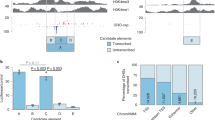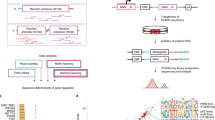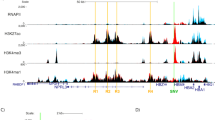Abstract
An essential requirement to understand how genes contribute to genetic disease is the thorough knowledge of the transcriptional regulation of gene expression. Here, we have characterized transcription factor binding sites within the type 1 neurofibromatosis (NF1) proximal regulatory region, and addressed the molecular mechanisms that regulate NF1 transcription. Overlapping regions of the NF1 proximal promoter have been cloned and characterized for use in luciferase reporter assays. These assays have identified a 500 bp region displaying activities up to 80-fold higher than control reporter levels. Mutations at putative CRE and SP1-binding sites immediately 5′ to the transcription start site have dramatic effects that lead to a 70–90% decrease in reporter activity in all cell lines tested. Gelshift assays confirm binding of CREB and SP1/KLF family members to their putative recognition sequences, and provide the first evidence identifying functional sites likely involved in regulating NF1 transcription. These assays have also revealed a putative repressor region within the NF1 promoter region corresponding to CCCTC-rich sequences between the transcription and translation start sites. This work provides new information concerning the transcriptional regulation of the NF1 gene, and is the most thorough attempt to date to map functionally relevant regions within the NF1 proximal promoter region.
This is a preview of subscription content, access via your institution
Access options
Subscribe to this journal
Receive 50 print issues and online access
$259.00 per year
only $5.18 per issue
Buy this article
- Purchase on Springer Link
- Instant access to full article PDF
Prices may be subject to local taxes which are calculated during checkout








Similar content being viewed by others
References
Adjei AA . (2001). J. Natl. Cancer Inst., 93, 1062–1074.
Bieker JJ . (2001). J. Biol. Chem., 276, 34355–34358.
Black AR, Black JD and Azizkhan-Clifford J . (2001). J. Cell Physiol., 188, 143–160.
Cichowski K and Jacks T . (2001). Cell, 104, 593–604.
Clark SJ and Melki J . (2002). Oncogene, 21, 5380–5387.
Crossley M, Whitelaw E, Perkins A, Williams G, Fujiwara Y and Orkin SH . (1996). Mol. Cell. Biol., 16, 1695–1705.
Dynan WS and Tjian R . (1985). Nature, 316, 774–778.
Evans DG, Baser ME, McGaughran J, Sharif S, Howard E and Moran A . (2002). J. Med. Genet., 39, 311–314.
Getman DK, Mutero A, Inoue K and Taylor P . (1995). J. Biol. Chem., 270, 23511–23519.
Guha A . (1998). Can. J. Neurol. Sci., 25, 267–281.
Hajra A, Martin-Gallardo A, Tarle SA, Freedman M, Wilson-Gunn S, Bernards A and Collins FS . (1994). Genomics, 21, 649–652.
Hofman KJ, Harris EL, Bryan NB and Denckla MS . (1994). J. Pediatr., 124, S1–S8.
Horan MP, Cooper DN and Upadhyaya M . (2000). Hum. Genet., 107, 33–39.
Jiang JG, DeFrances MC, Machen J, Johnson C and Zarnegar R . (2000). Biochem. Biophys. Res. Commun., 272, 882–886.
Jones PA . (2002). Oncogene, 21, 5358–5360.
Kim HA, Ratner N, Roberts TM and Stiles CD . (2001). J. Neurosci., 21, 1110–1116.
Kino T, Takeshima H, Nakao M, Nishi T, Yamamoto K, Kimura T, Saito Y, Kochi M, Kuratsu J, Saya H and Ushio Y . (2001). Genes Cells, 6, 441–454.
Luijten M, Redeker S, van Noesel MM, Troost D, Westerveld A and Hulsebos TJ . (2000). Eur. J. Hum. Genet., 8, 939–945.
Mancini DN, Rodenhiser DI, Ainsworth PJ, O'Malley FP, Singh SM, Xing W and Archer TK . (1998). Oncogene, 16, 1161–1169.
Mancini DN, Singh SM, Archer TK and Rodenhiser DI . (1999). Oncogene, 18, 4108–4119.
Mancini-Dinardo DN, Butcher DT, Robinson DP, Archer TK and Rodenhiser DI . (2001). Oncogene, 20, 5331–5340.
NIH Consensus Statement (1988). Neurofibromatosis. Conference statement. National Institutes of Health Consensus Development Conference: Neurofibromatosis Conference Statement. Arch. Neurol., 45, 575–578.
Plass C and Soloway PD . (2002). Eur. J. Hum. Genet., 10, 6–16.
Reed N and Gutmann DH . (2001). Trends Mol. Med., 7, 157–162.
Robertson KD . (2002). Oncogene, 21, 5361–5379.
Rubenstein AE and Korf BR . (1990). Neurofibromatosis: a Handbook for Patients, Families, and Health-Care Professionals. Thieme Medical Publishers: New York.
Stiller CA, Chessells JM and Fitchett M . (1994). Br. J. Cancer, 70, 969–972.
Suske G . (1999). Gene, 238, 291–300.
Stumpf DA, Alksne JF, Annegers JF, Brown SS, Conneally PM, Housman D, Leppert MF, Miller JP, Moss ML, Pileggi AJ, Rapin I, Strohman RC, Swanson LW and Zimmerman A . (1988). Arch. Neurol., 45, 575–578.
Tong J, Hannan F, Zhu Y, Bernards A and Zhong Y . (2002). Nat. Neurosci., 5, 95–96.
Zoller M, Rembeck B, Akesson HO and Angervall L . (1995). Acta. Derm. Venereol., 75, 136–140.
Acknowledgements
This work was funded by the United States Department of Defense Congressionally Directed Medical Research Program (CDMRP) through the Neurofibromatosis Research Program (Contract no. DAMD17-00-1-0540). Darci Butcher is funded by an CRCC/CIHR partnered fellowship.
Author information
Authors and Affiliations
Corresponding author
Rights and permissions
About this article
Cite this article
Zou, MX., Butcher, D., Sadikovic, B. et al. Characterization of functional elements in the neurofibromatosis (NF1) proximal promoter region. Oncogene 23, 330–339 (2004). https://doi.org/10.1038/sj.onc.1207053
Received:
Revised:
Accepted:
Published:
Issue Date:
DOI: https://doi.org/10.1038/sj.onc.1207053



